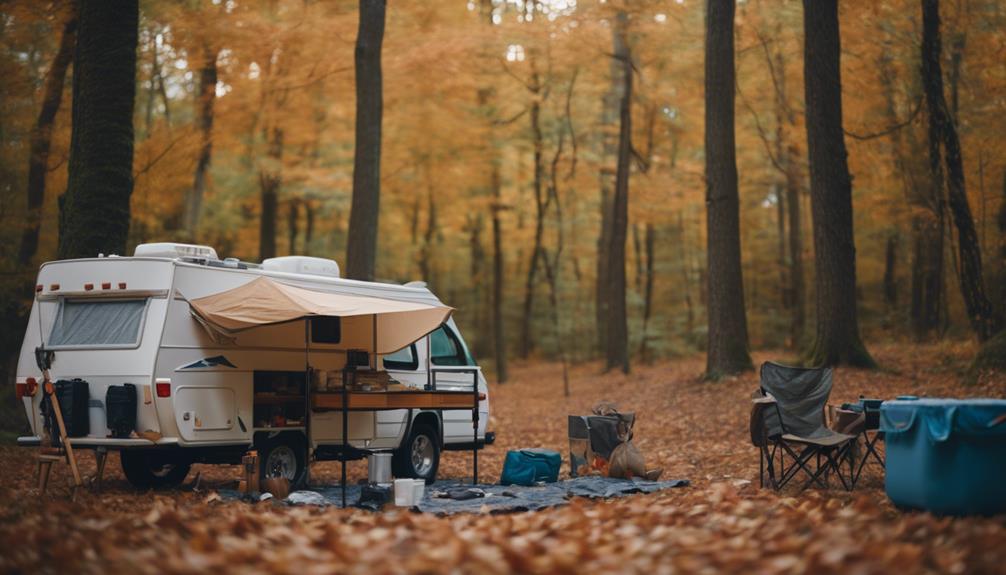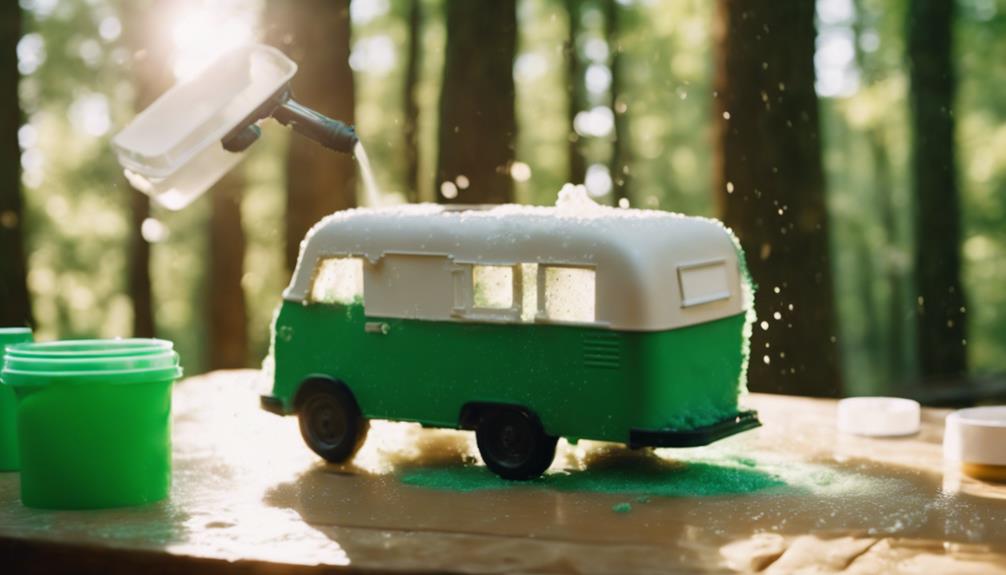To store your pop-up camper off-season, start by cleaning it thoroughly to prevent mildew and pests. If possible, opt for indoor storage to shield it from harsh weather; otherwise, use a solid surface for outdoor storage. Elevate your camper on blocks to avoid moisture damage. Seal all openings to keep pests out and use moisture absorbers like DampRid. Cover your camper with a heavy-duty tarp, guaranteeing good ventilation. Regularly check for signs of damage and pest activity. You'll find valuable tips to guarantee a successful winter storage by exploring more options for safeguarding your camper.
Key Takeaways
- Thoroughly clean and inspect the camper before storage to prevent mold and pest infestations.
- Winterize plumbing by draining water lines and adding antifreeze to prevent freeze damage.
- Store the camper indoors if possible, or on a hard surface outdoors to minimize moisture risks.
- Cover the camper with a heavy-duty tarp, ensuring ventilation and regular snow removal to prevent structural damage.
Winter Storage Considerations
When winter arrives, taking the right steps to store your pop-up camper will help protect it from damage and pests. One of the best options is indoor storage. Storing your camper inside keeps it safe from harsh weather, reducing the risk of rust, moisture issues, and potential infestations.
If indoor storage isn't possible, choose a hard surface for outdoor storage to minimize these risks.
Before placing your camper in storage, conduct a thorough inspection. Seal any openings to prevent mice and other pests from getting inside. It's also wise to use moisture-absorbing products like DampRid to lower humidity levels and help prevent mold development.
Regularly check on your camper during winter months, verifying everything remains intact.
If you do decide to cover your camper outdoors, make certain it's with a breathable tarp to avoid moisture buildup. Remove any accumulated snow from the cover to prevent structural damage.
Covering Techniques
When it comes to covering your pop-up camper, choosing the right tarp and placing it correctly is essential for protection.
You'll want to secure your covers effectively to withstand harsh weather and manage snow accumulation to prevent damage.
Let's explore the best techniques to guarantee your camper stays safe and sound through the winter months.
Tarp Selection and Placement
Selecting the right tarp material is essential for effectively protecting your pop-up camper from the harsh elements, especially in regions that experience heavy snowfall. Choose a heavy-duty tarp that can withstand the weight of snow and resist tearing.
When placing the tarp, make sure it covers your camper just below where the top meets the body. This placement allows for proper ventilation and helps prevent moisture buildup, which can lead to mold and mildew.
Use bungee cords to secure the tarp tightly, making sure it doesn't shift or flap during storms or high winds. This added stability will protect your camper from potential damage caused by the tarp moving against the surface.
Don't forget to regularly remove any snow accumulation from the tarp. Excessive weight can compromise the structure of your camper, leading to costly repairs.
For an extra layer of protection, consider adding a breathable RV cover, like ADCO, underneath the tarp. This combination will enhance moisture protection while still allowing airflow, helping to keep your pop-up camper in prime condition during the off-season.
Securing Covers Effectively
Properly securing your covers is essential to guarantee your pop-up camper remains protected from harsh weather conditions during storage. A sturdy cover not only shields your camper from rain and snow but also allows for ventilation, preventing moisture buildup.
Here are some effective techniques to secure your covers:
- Use a Heavy-Duty Tarp or Breathable RV Cover: Make sure it covers just below where the top meets the body of the camper, allowing for airflow.
- Secure with Bungie Cords or Straps: These will prevent movement during storms, especially if you live in snow-heavy regions. This step is vital to avoid potential damage.
- Inspect Regularly: Check the integrity of your covers throughout the winter. Replace or reinforce them as needed to maintain protection.
- Consider Additional Tarp Protection: Place a tarp underneath your camper to control moisture and prevent rust, especially when storing on grass or dirt surfaces.
Snow Accumulation Management
Managing snow accumulation on your pop-up camper is vital to prevent structural damage and costly repairs. Snow weight can lead to damages exceeding $4000 if not properly managed.
Regularly check your camper covers and remove any snow that builds up. Using heavy-duty tarps is especially important in snow-heavy regions; cover your camper just below where the top meets the body. This technique guarantees effective ventilation while managing snow accumulation.
Secure your tarps with bungee cords to keep them in place during storms. This will help maintain the integrity of your covering and protect your camper against harsh winter conditions.
Additionally, consider placing a heavy-duty plastic sheet or tarp underneath the camper. This provides moisture protection, which is essential since excess moisture can lead to mold and mildew if left unchecked.
Throughout the winter, regularly inspect the condition of your covers. Maintaining their integrity guarantees they function as intended, allowing you to address any potential issues early.
Mice Prevention Strategies
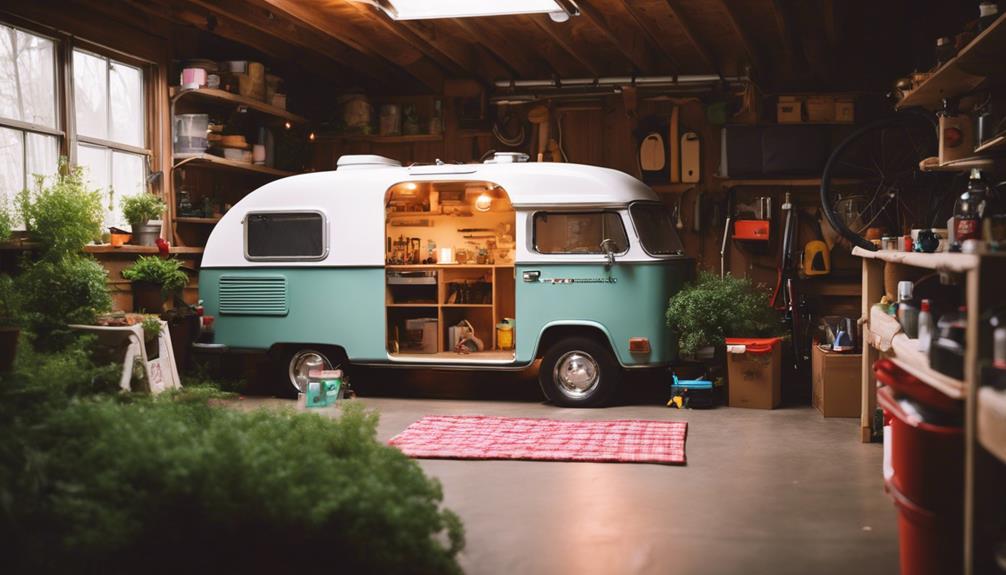
When storing your pop-up camper, it's essential to implement effective mice prevention strategies.
Start by sealing all openings and using natural deterrents like peppermint oil to keep these pests at bay.
Regular inspections can help you catch any potential issues early, ensuring your camper stays rodent-free.
Seal All Openings
Sealing all openings in your pop-up camper is essential to keep rodents from making it their winter home. Mice can squeeze through surprisingly small gaps, so you need to be thorough. Here are some steps you can take to effectively seal all openings:
- Inspect Vents and Windows: Check for cracks or gaps around vents and windows. Use high-quality caulk or expanding foam to fill any openings.
- Gaps in Doors: Pay close attention to the edges of doors, where gaps can easily arise. Seal these areas with weather stripping or caulk.
- Install Mesh Screens: For ventilation, consider installing mesh screens over vents. This allows airflow while blocking rodents from entering.
- Remove Food and Debris: Before storing, make sure to remove all food items and clean the interior. Even tiny crumbs can attract pests.
Regularly inspect your camper for signs of rodent activity, such as droppings or gnaw marks.
With these strategies, you can effectively seal all openings and keep your pop-up camper safe during the off-season.
Natural Deterrents
Utilizing natural deterrents can greatly enhance your efforts to prevent mice from invading your pop-up camper. These strategies offer effective and safe ways to keep these pests at bay.
| Deterrent Method | How to Use | Effectiveness |
|---|---|---|
| Peppermint Oil | Soak cotton balls in oil and place them around the camper. | Strong scent repels mice. |
| Mothballs | Place mothballs in various areas inside the camper. | Emits an unpleasant odor for rodents. |
| Seal Openings | Inspect and seal any gaps or holes in the camper's structure. | Prevents entry points. |
| Food Storage | Confirm no food items are left inside. | Eliminates attractants. |
| Regular Maintenance | Check for signs of rodent activity periodically. | Allows for timely intervention. |
Regular Inspections
Regular inspections of your pop-up camper are essential for spotting signs of mice and addressing any issues before they escalate into a full-blown infestation.
By conducting regular inspections, you can catch potential problems early and take the necessary steps to keep your camper rodent-free.
Here are some effective mice prevention strategies to incorporate into your routine:
- Check for Droppings: Regularly inspect for signs of mouse droppings or nesting materials, as these can indicate an infestation.
- Seal Openings: Inspect and maintain all seals and caulking around windows, doors, and vents to prevent mice from sneaking in.
- Use Deterrents: Place cotton balls soaked in peppermint oil or strategically positioned mothballs throughout the camper to deter rodents with their strong scents.
- Maintain Cleanliness: Keep the interior of your camper clean and free of food remnants, which can attract mice looking for a meal.
Damage Risks
Improperly covering your pop-up camper during off-season storage can open the door to serious damage, leading to costly repairs that might exceed $4,000. One of the most significant damage risks comes from mold, which thrives in damp and poorly ventilated spaces. If you don't maintain proper ventilation and moisture control, you could face extensive cleaning and repairs.
Additionally, mice pose a real threat. These critters can wreak havoc on your upholstery and internal components if you don't seal all openings and keep the interior clean. Leaving food scraps or unsealed gaps makes your camper an inviting home for them.
Snow accumulation on your camper cover is another danger. The weight from snow can compromise the structural integrity, so you need to monitor and clear it regularly.
Community Insights and Recommendations
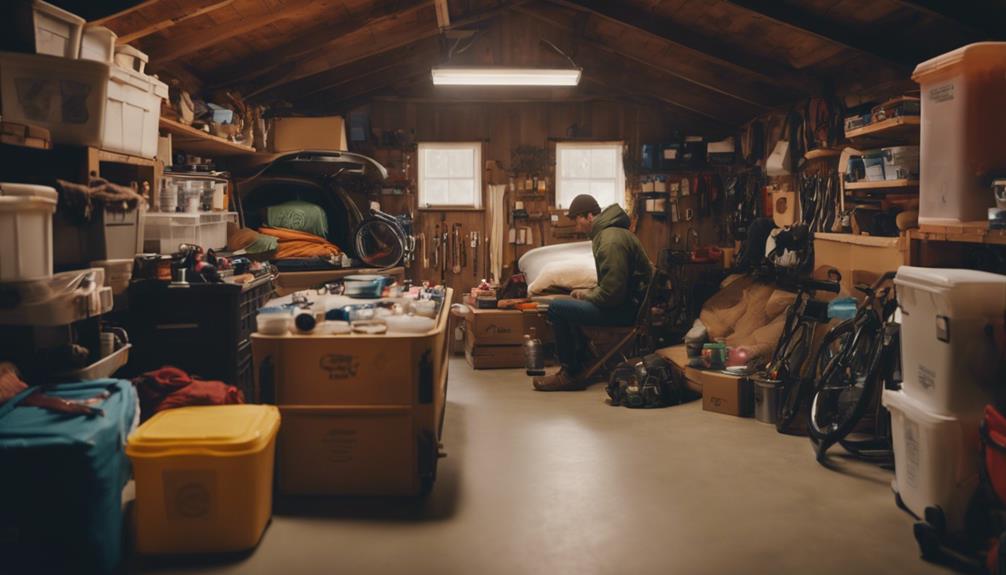
As you prepare to store your pop-up camper, it's helpful to tap into the experiences of fellow campers.
They've shared effective pest control measures, recommended storage solutions, and essential maintenance tips that can save you time and hassle.
Engaging with the community will give you practical insights to keep your camper in great shape.
Effective Pest Control Measures
Effective pest control measures for your pop-up camper can make a significant difference in preventing infestations during storage. By taking proactive steps, you can create an environment that deters pests and keeps your camper safe. Here are some effective strategies to take into account:
- Peppermint Oil: Soak cotton balls in peppermint oil and place them inside your camper. This natural deterrent masks food scents and creates an unpleasant environment for rodents.
- Mothballs: While traditional, mothballs can repel vermin. However, be cautious, as they can be harmful to pets and children if ingested.
- Sealing Openings: Regularly inspect your camper and seal any gaps or openings. Even small spaces can invite pests, making this an essential step in pest control.
- Fresh Cab Products: Think about using Fresh Cab pest control products, which repel rodents without using harmful chemicals, creating a safer storage option.
Additionally, engage neighbors or friends to monitor your camper during the off-season, helping you catch any signs of pest activity early.
Taking these measures can save you from headaches later on!
Recommended Storage Solutions
Choosing the right storage solution for your pop-up camper is essential to ensuring its longevity and protection against the elements.
Indoor storage is highly recommended, as it shields your camper from weather damage, mold, and wear. While outdoor storage may seem convenient, it can lead to costly repairs averaging $4000 due to environmental exposure.
If indoor storage isn't an option, consider outdoor solutions like concrete pads or paver stones. These provide a stable surface, preventing rust and moisture-related issues, especially during spring. Look for local storage facilities that offer winter protection options and are situated in flat, dry areas to avoid water pooling around your camper.
Community insights also suggest building a metal or DIY wooden carport for additional protection. This not only keeps your camper safe from the elements but also makes accessing it easier during winter months.
Regardless of your choice, don't forget to use a plastic cover to shield your camper further. Regular inspections and maintenance are vital, so consider using products like DampRid to absorb moisture and prolong your camper's lifespan.
Maintenance Tips From Community
Community members share valuable maintenance tips that can help you keep your pop-up camper in top shape during off-season storage. By following these suggestions, you'll protect your investment and guarantee it's ready for your next adventure.
- Use Heavy-Duty Tarps: Cover your camper with a heavy-duty tarp or a breathable RV cover to shield it from moisture, preventing mold and mildew.
- Regular Inspections: Check your camper regularly throughout the winter. Look for signs of rodent activity and guarantee that covers and seals are intact.
- Deter Rodents: Place cotton balls soaked in peppermint oil or mothballs inside your camper to keep those pesky mice away. This natural deterrent is effective and safe.
- Store the Battery Properly: Always store your battery in a warm, dry location. Lubricate the hinges before you tuck the camper away to maintain functionality.
Additionally, consider using DampRid inside the camper to absorb moisture, effectively preventing musty odors and mold growth.
With these community tips, you can rest easy knowing your pop-up camper will be ready for your next outing.
Storage Location and Structures
Finding the right storage location for your pop-up camper is essential to protecting it from the elements and ensuring its longevity. Indoor storage is the best option since it shields your camper from weather-related damage. If indoor storage isn't feasible, consider outdoor options, but be aware of the potential risks. Here's a quick guide to help you choose the best storage location:
| Storage Type | Pros | Cons |
|---|---|---|
| Indoor Storage | Protects from elements, extends lifespan | Higher cost, limited space |
| Outdoor Storage | More accessible, lower cost (~$50/month) | Exposed to weather, potential damage |
| DIY Structures | Customizable protection, cost-effective | Requires time and effort |
When storing outdoors, find a flat, dry area to avoid water pooling and debris accumulation. Using concrete pads or paver stones creates a stable surface, preventing rusting and moisture issues. Park your camper at an angle to facilitate runoff. For added protection, consider building a metal carport or a wooden structure, especially in areas with heavy snowfall. Taking these steps will help keep your pop-up camper in great shape for the next camping season!
Camper Preparation Practices
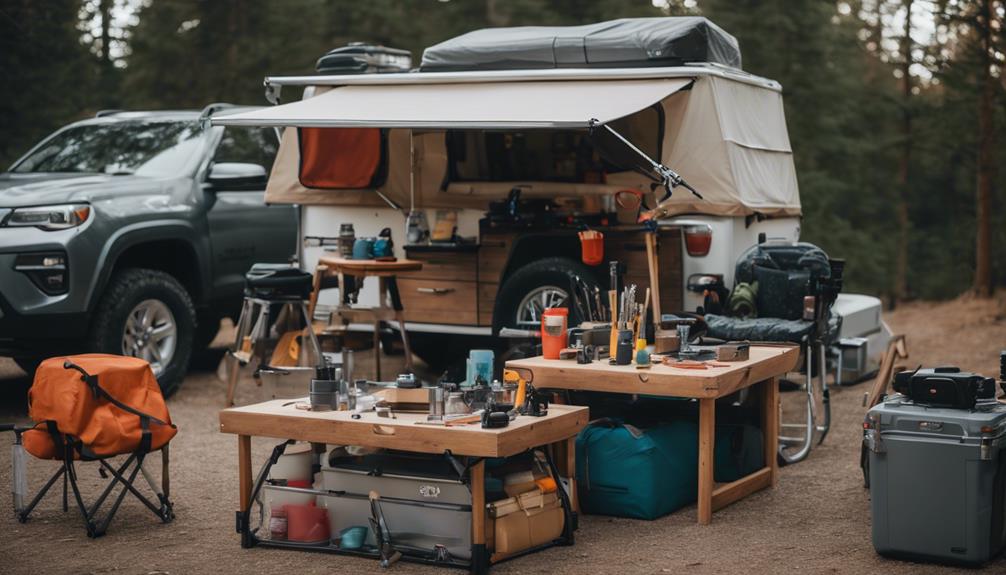
Preparing your pop-up camper for storage is essential for maintaining its condition and preventing damage during the off-season. Implementing effective camper preparation practices will help guarantee your camper stays in great shape for your next adventure. Here are four key steps you should take:
- Winterize the Plumbing: Drain all water lines and tanks, then add antifreeze to the plumbing system. This prevents freezing and potential damage.
- Inspect Seals and Vents: Check all seals and caulking for leaks, and make sure vents are intact. This helps prevent moisture entry during storage.
- Clear the Interior: Remove all cushions, paper goods, and food items to deter pests. Use moisture absorbers to reduce humidity levels inside the camper.
- Clean and Ventilate: Thoroughly clean and vacuum the interior to eliminate debris. Leave cabinets and doors slightly ajar for ventilation to prevent mold and mildew.
Additionally, store the battery in a warm, dry location to maintain its charge, and lubricate hinges before storage to prevent rust.
Following these camper preparation practices will keep your pop-up camper safe and ready for your next trip.
Exterior Protection Methods
Protecting the exterior of your pop-up camper during storage is essential for preventing damage from harsh winter elements. One of the best ways to do this is by using a heavy-duty tarp or a breathable RV cover. Make sure the cover extends just below where the top meets the body of the camper to allow for proper ventilation and moisture control. This will help prevent the buildup of snow and ice, which can lead to costly repairs.
Regularly check your camper throughout the winter months. Remove any snow accumulation from the RV cover to avoid structural damage, as excess weight can result in repairs costing over $4000. Secure the tarp with bungee cords to keep it in place during storms, especially in areas prone to heavy snowfall.
Additionally, store your camper on a flat, dry surface to prevent water pooling around it. If possible, place it at an angle to facilitate runoff and avoid standing water.
Maintenance During Storage
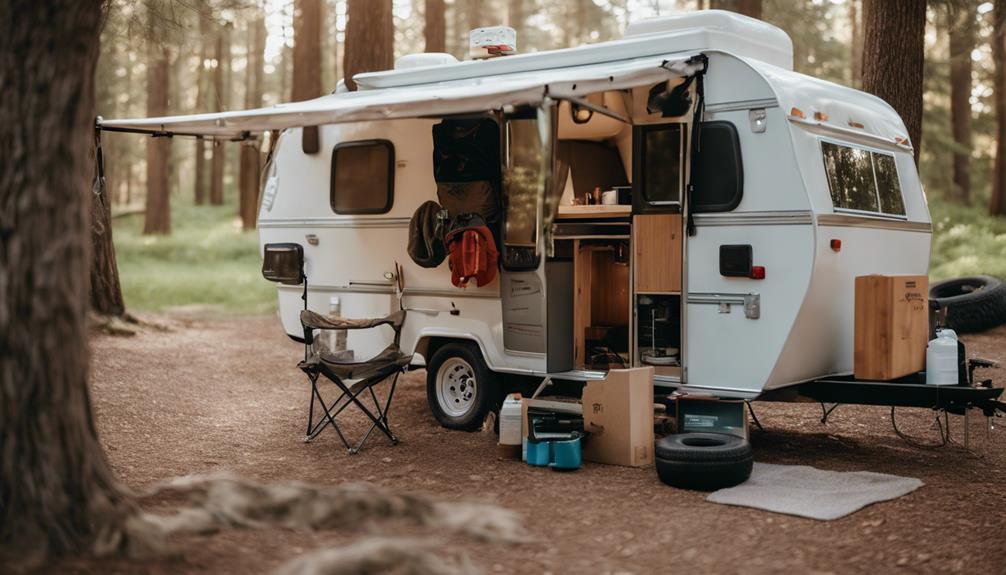
Maintaining your pop-up camper during storage is just as important as protecting its exterior, ensuring it stays in prime condition for your next adventure. To effectively carry out maintenance during storage, follow these key steps:
- Regular Cleaning: Clean the camper thoroughly before storing it. Aim for a deep clean twice a year to prevent mildew and odors from taking hold.
- Monthly Inspections: Conduct inspections monthly to check for discoloration, mold, or any signs of pests. Keeping the interior clean and free of debris is essential for its longevity.
- Use Moisture Absorbers: Place moisture absorbers like DampRid inside the camper to reduce humidity levels. This helps prevent mold growth, ensuring a fresh environment.
- Seal and Canvas Checks: Inspect all seals and the canvas for integrity. Any leaks or damage should be repaired before storing to protect against water damage.
Additionally, elevate the camper on blocks to prevent tire flat spots and safeguard the undercarriage from moisture.
Pest Control Measures
Effective pest control measures are essential for keeping your pop-up camper free from unwanted guests during storage. To start, remove all food items and potential attractants, as even small crumbs can invite rodents and other pests. Next, seal all openings, including vents and seams, to block access points that pests may use to enter.
Here's a quick reference table for effective pest control measures:
| Method | Description | Frequency |
|---|---|---|
| Peppermint Oil | Place peppermint oil-soaked cotton balls | Before storage |
| Mothballs | Use mothballs inside the camper to deter pests | Monthly checks |
| Cleanliness | Maintain a clean space by removing food items | Before storage |
| Regular Inspections | Check for signs of pests throughout storage | Every few weeks |
Additionally, conduct regular inspections throughout the storage period to identify signs of pests early. By implementing these pest control measures, you can guarantee your pop-up camper remains pest-free, ready for your next adventure!
Frequently Asked Questions
How to Store a Pop-Up Camper in the Winter?
To store your pop-up camper in winter, winterize it by draining water lines and adding antifreeze. Cover it with a tarp, secure all openings, and check regularly for snow and pest issues.
How to Store a Camper Outside for Winter?
To store your camper outside for winter, find a flat, dry area, cover it with a heavy-duty tarp, and elevate it on blocks. Don't forget to seal openings and regularly check for snow buildup.
Can Pop-Up Campers Be Stored Outside?
Yes, you can store pop-up campers outside, but it's risky. Make certain you place them on hard surfaces, cover them properly, and inspect regularly to prevent moisture and pest issues that could lead to damage.
Should I Put a Tarp Over My Camper for the Winter?
Yes, you should put a tarp over your camper for the winter. It protects against snow and ice, prevents moisture buildup, and helps avoid costly structural damage. Just secure it properly for ventilation and stability.
Are Proper Storage Methods Essential for Maintaining a Pop-Up Camper’s Longevity?
Proper storage methods are essential for maintaining a pop-up camper’s longevity. Following these popup camper maintenance tips can ensure that your camper stays in good condition and is ready to use whenever you need it. Storing it in a dry, covered area and regularly inspecting for any damage or wear are crucial steps in prolonging its lifespan.
Conclusion
To summarize, properly storing your pop-up camper during the off-season is vital to guarantee its longevity and performance.
For instance, a friend of mine ignored pest control measures and found a family of mice had made a nest inside their camper, causing extensive damage.
By following the tips outlined, you can avoid similar pitfalls and keep your camper in top shape.
Remember, a little effort now can save you from costly repairs later!

